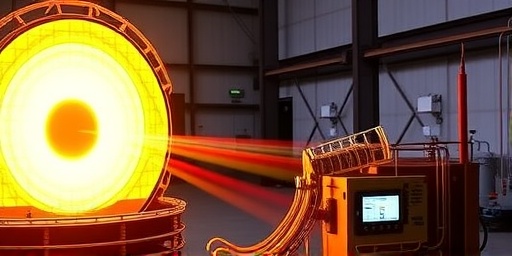In a monumental leap forward for clean energy, researchers at the National Ignition Facility (NIF) in Livermore, California, have announced they produced 2.5 times more energy from a nuclear fusion reaction than the energy required to spark it. This historic net energy gain, achieved on December 5, 2022, represents the first time humanity has crossed this critical threshold in controlled fusion experiments, edging closer to the dream of unlimited, sustainable Fusion energy.
The experiment, conducted using the world’s most powerful laser system, involved firing 192 high-powered lasers at a tiny fuel pellet containing isotopes of hydrogen. The resulting implosion created conditions mimicking the sun’s core, fusing atoms and releasing a burst of energy equivalent to 3.15 megajoules—outpacing the 1.3 megajoules of laser energy delivered. While this is still a fraction of the total facility power draw, it marks a pivotal scientific milestone in the quest for commercial nuclear fusion.
Inside the NIF Experiment: Lasers Ignite Fusion Ignition
At the heart of this breakthrough is the National Ignition Facility, a $3.5 billion project operated by Lawrence Livermore National Laboratory under the U.S. Department of Energy. The NIF’s setup is nothing short of engineering marvel: its 192 ultraviolet lasers, each capable of delivering the energy of a power plant in nanoseconds, converge on a gold-lined cylinder called a hohlraum. Inside, a diamond capsule holds the deuterium-tritium fuel pellet, just two millimeters wide.
During the December experiment, the lasers heated the hohlraum to over 3 million degrees Celsius, generating X-rays that symmetrically compressed the pellet. This extreme pressure—reaching 100 billion times Earth’s atmosphere—triggered inertial confinement fusion, where the fuel ignites and propagates a self-sustaining burn. “We have achieved ignition,” declared Dr. Omar Hurricane, chief scientist for NIF’s inertial confinement fusion program. “This is a game-changer for Fusion energy research.”
Previous attempts at NIF had come close; in August 2021, the facility achieved a yield of 1.3 megajoules, nearly matching input but falling short of net gain. Iterative improvements in laser precision, target design, and diagnostic tools pushed the efficiency higher. Data from the experiment showed not only the energy output but also neutron yields confirming true fusion ignition—a chain reaction where the burn propagates through the fuel.
This success builds on decades of international efforts. Unlike magnetic confinement approaches like ITER in France, NIF’s laser-based method focuses on short, intense pulses rather than sustained reactions. Yet, the net energy gain here is specifically for the fusion process itself, excluding the facility’s overall electrical consumption, which remains a hurdle for scalability.
Decades of Pursuit: From Cold War Origins to Fusion Milestone
Nuclear fusion has tantalized scientists since the 1950s, promising a clean energy source without the long-lived radioactive waste of fission reactors. The U.S. fusion program traces back to the Atoms for Peace era, but gained urgency during the Cold War with projects like the Shiva laser in the 1970s. NIF itself, authorized in 1995, was initially designed to simulate nuclear weapons without live tests, aligning with non-proliferation treaties.
Over the years, fusion research has faced skepticism and funding battles. In the 1980s, the “cold fusion” debacle—claims of room-temperature fusion that couldn’t be replicated—set back public trust. More recently, private ventures like Commonwealth Fusion Systems and TAE Technologies have injected billions, but government labs like NIF provide the rigorous, peer-reviewed foundation.
Statistics underscore the challenge: Fusion requires temperatures of 100 million degrees Celsius, pressures unattainable on Earth without advanced tech. Global investment in fusion now exceeds $4 billion annually, with the U.S. leading through programs like ARPA-E. This net energy gain at NIF validates those investments, proving that nuclear fusion can indeed produce more energy than consumed in the reaction chamber.
Contextually, this isn’t isolated. In 2022 alone, the Joint European Torus (JET) in the UK set a sustained fusion power record of 59 megajoules over five seconds. Yet NIF’s achievement stands out for demonstrating ignition—a holy grail where output exceeds input for the fuel burn. As Dr. Kim Budil, lab director at Lawrence Livermore, noted in the announcement, “The potential payoff for this breakthrough is enormous: clean energy from seawater-derived fuel, no carbon emissions, and energy security for generations.”
Expert Voices: Celebrating the Dawn of Viable Fusion energy
The scientific community erupted in praise following the NIF announcement. Dr. Ian Chapman, CEO of the UK Atomic Energy Authority, called it “a monumental step,” emphasizing how it complements magnetic fusion efforts worldwide. In the U.S., fusion advocates like Michel Laberge of General Fusion hailed it as proof that fusion energy is no longer science fiction.
Critics, however, urge caution. Dr. Daniel Jassby, a plasma physicist and fusion skeptic, pointed out in a recent op-ed that the experiment’s energy gain (Q=2.5) is for the target only, not the full system efficiency, which might be as low as 0.01%. “Net energy gain is exciting, but engineering a power plant from this is a different beast,” he said. Nonetheless, even skeptics acknowledge the data’s integrity, verified by independent reviews.
Industry experts weigh in optimistically. Venture capitalist Josh Wolfe of Lux Capital, which funds fusion startups, stated, “This de-risks the field. Investors will pour in, accelerating timelines for commercial reactors.” Quotes from international bodies like the IAEA underscore global collaboration: “NIF’s success inspires the worldwide push for sustainable energy,” said Director General Rafael Grossi.
Public reaction, amplified on social media, mixes awe with hope. Hashtags like #FusionBreakthrough trended, with users sharing visions of a fossil-fuel-free future. Polls from Pew Research show 70% of Americans support increased fusion funding, reflecting broad appeal for clean energy solutions amid climate urgency.
Charting the Road to Commercial Fusion: Challenges and Horizons
While the NIF milestone propels nuclear fusion forward, commercialization remains years away—likely 10-20, per experts. Key challenges include repeating the feat consistently, scaling to megawatt outputs, and developing affordable tritium breeding for fuel self-sufficiency. The current lasers consume massive electricity; future designs might use diodes for efficiency gains up to 10%.
Looking ahead, Lawrence Livermore plans 10-20 experiments annually at NIF to refine techniques. Private sector momentum is building: Helion Energy aims for a prototype by 2024, targeting net electricity gain. Governments are responding too—the U.S. Inflation Reduction Act allocates $1 billion for fusion R&D, while the EU’s €5 billion ITER project nears operation in 2025.
Implications ripple across sectors. For climate change, fusion could decarbonize grids, complementing renewables like solar and wind. The fuel—deuterium from seawater and tritium from lithium—ensures abundance, potentially powering the world with devices the size of shipping containers. Economically, it promises trillions in savings on energy imports and health costs from pollution.
Geopolitically, fusion enhances energy independence. Nations like China, with its EAST tokamak holding temperature records, and South Korea are ramping up, fostering a global race. As Dr. Budil envisions, “By the 2030s, we could see pilot plants demonstrating grid-connected fusion power.” This net energy gain isn’t just a lab victory; it’s a beacon for humanity’s energy future, blending scientific triumph with urgent environmental needs.
In parallel developments, NIF’s dual-use for stockpile stewardship ensures ongoing funding, bridging national security with clean energy goals. Educational outreach, including virtual tours and STEM programs, aims to inspire the next generation of physicists. Ultimately, this breakthrough at NIF doesn’t solve all problems but ignites a path where fusion energy becomes a cornerstone of sustainable progress.









